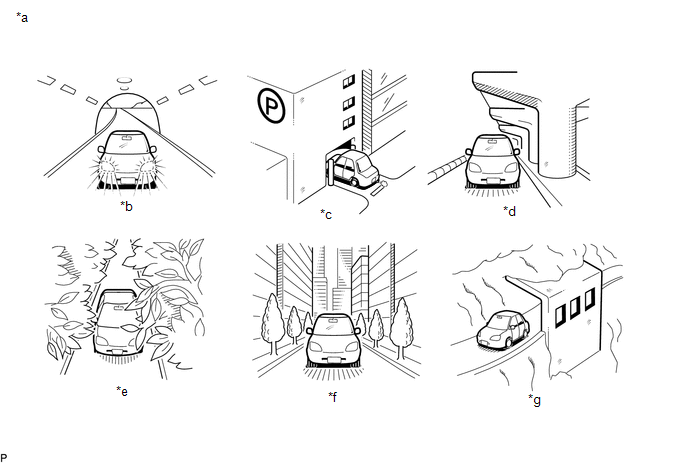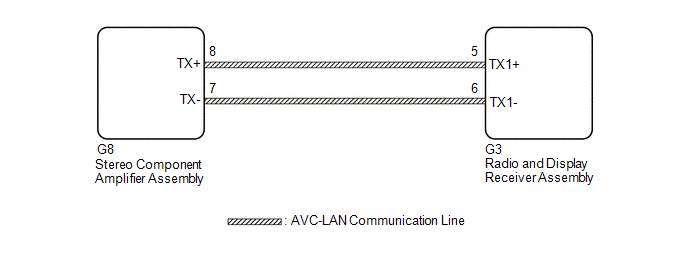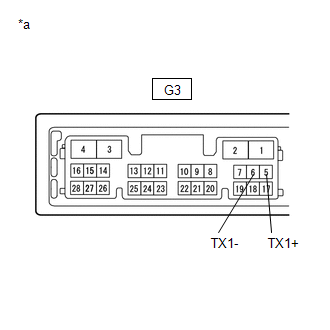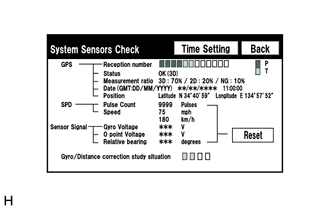"No GPS signal" mark is displayed
CAUTION / NOTICE / HINT
NOTICE:
- Depending on the parts that are replaced during vehicle inspection or
maintenance, performing initialization, registration or calibration may
be needed. Refer to Precaution for Navigation System.
Click here 
- When replacing the radio and display receiver assembly, always replace
it with a new one. If a radio and display receiver assembly which was
installed to another vehicle is used, the following may occur:
- A communication malfunction DTC may be stored.
- The radio and display receiver assembly may not operate normally.
PROCEDURE
(a)
Check the cabin for any object that might interrupt radio reception or
additional devices which use radio waves on the instrument panel. If
such an object exists, remove it and check if the "No GPS signal" mark
disappears.
HINT:
The GPS
uses extremely weak radio waves originating from satellites. If the
signal is interrupted by obstructions or other radio waves, the GPS may
not be able to properly receive the signal.
OK:
The "No GPS signal" mark disappears.
| OK |
 | END |
|
NG |
 | |
(a)
Check if the vehicle is in a location where GPS signal reception is
poor. If the vehicle is in such a place, relocate the vehicle and check
if the "No GPS signal" mark disappears.
HINT:
The
GPS uses 24 satellites in 6 orbits. At any point in time, 4 satellites
should be able to pinpoint your vehicle. However, GPS signals may not
reach the vehicle due to influence from the surroundings, vehicle
direction and time. For examples, see the following illustration.

|
*a | Example |
*b | In a tunnel |
|
*c | In a building |
*d | Under an overpass |
|
*e | On a forest or tree-lined path |
*f | Between tall buildings |
|
*g | Under a cliff or overhang |
- | - |
OK:
The "No GPS signal" mark disappears.
| OK |
 | SYSTEM RETURNS TO NORMAL |
|
NG |
 | |
| 3. |
CHECK GPS INFORMATION (OPERATION CHECK) |
| (a) Enter the "System Sensors Check" screen. Refer to Check GPS & Vehicle Sensors in Operation Check.
Click here  | |
(b) Check how many of the following codes appear in the "Reception number" column.
HINT:
T or P appears.
OK:
At least 3 codes appear.
| OK |
 | REPLACE RADIO AND DISPLAY RECEIVER ASSEMBLY |
| NG |
 | PROCEED TO NEXT SUSPECTED AREA SHOWN IN PROBLEM SYMPTOMS TABLE |
AVC-LAN Circuit
DESCRIPTION
Each unit of the navigation system connected to the AVC-LAN (communication bus) transmits signals via AVC-LAN communication.
If
a short to +B or short to ground occurs in an AVC-LAN communication
line, the navigation system will not function normally because
communication is not possible.
WIRING DIAGRAM

CAUTION / NOTICE / HINT
NOTICE:
- Depending on the parts that are replaced during vehicle inspection or
maintenance, performing initialization, registration or calibration may
be needed. Refer to Precaution for Navigation System.
Click here 
- When replacing the radio and display receiver assembly, always replace
it with a new one. If a radio and display receiver assembly which was
installed to another vehicle is used, the following may occur:
- A communication malfunction DTC may be stored.
- The radio and display receiver assembly may not operate normally.
HINT:
The radio and display receiver assembly is the master unit.
PROCEDURE
| 1. |
INSPECT RADIO AND DISPLAY RECEIVER ASSEMBLY |
(a) Remove the radio and display receiver assembly.
| (b) Measure the resistance according to the value(s) in the table below.
Standard Resistance: |
Tester Connection | Condition |
Specified Condition | |
G3-5 (TX1+) - G3-6 (TX1-) |
Always | 60 to 80 Ω | |
 |
|
*a | Component without harness connected
(Radio and Display Receiver Assembly) | | |
| NG |
 | REPLACE RADIO AND DISPLAY RECEIVER ASSEMBLY |
|
OK |
 | |
| 2. |
CHECK HARNESS AND CONNECTOR (AVC-LAN CIRCUIT) |
(a) Disconnect the G3 radio and display receiver assembly connector.
(b) Disconnect the G8 stereo component amplifier assembly connector.
(c) Measure the resistance according to the value(s) in the table below.
Standard Resistance:
|
Tester Connection | Condition |
Specified Condition |
|
G8-8 (TX+) - G3-5 (TX1+) |
Always | Below 1 Ω |
|
G8-7 (TX-) - G3-6 (TX1-) |
Always | Below 1 Ω |
|
G8-8 (TX+) or G3-5 (TX1+) - Body ground |
Always | 10 kΩ or higher |
|
G8-7 (TX-) or G3-6 (TX1-) - Body ground |
Always | 10 kΩ or higher |
| NG |
 | REPAIR OR REPLACE HARNESS OR CONNECTOR |
|
OK |
 | |
| 3. |
INSPECT MALFUNCTIONING PARTS |
(a) Disconnect and reconnect each slave unit one by one until the master unit returns to normal.
HINT:
- Check all slave units.
- If disconnecting a slave unit causes the master unit to return to normal, the slave unit is defective and should be replaced.
OK:
Master unit returns to normal.
| OK |
 | REPLACE MALFUNCTIONING PARTS |
| NG |
 | REPLACE RADIO AND DISPLAY RECEIVER ASSEMBLY |
Stereo Component Amplifier Malfunction (B15A3)
DESCRIPTION
This DTC is stored when a malfunction occurs in the stereo component amplifier assembly.
|
DTC No. | Detection Item |
DTC Detection Condition | Trouble Area |
|
B15A3 | Stereo Component Amplifier Malfunction |
When any of the following conditions is met:
- Internal power supply malfunction
- DSP error
- EEPROM error
| Stereo component amplifier assembly |
PROCEDURE
(a) Clear the DTCs.
Body Electrical > Navigation System > Clear DTCs
(b) Recheck for DTCs and check that no DTCs are output.
Body Electrical > Navigation System > Trouble Codes
OK:
No DTCs are output.
| OK |  |
USE SIMULATION METHOD TO CHECK |
| NG |
 | REPLACE STEREO COMPONENT AMPLIFIER ASSEMBLY |




















